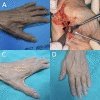The Isolated Motor Branch of the Ulnar Nerve Injury During Open Carpal Tunnel Release
- PMID: 37719604
- PMCID: PMC10504059
- DOI: 10.7759/cureus.43601
The Isolated Motor Branch of the Ulnar Nerve Injury During Open Carpal Tunnel Release
Abstract
A 76-year-old woman underwent open carpal tunnel release (OCTR). She had sudden sharp shooting pain in her hand, in the mid-palmar area, during the operation. She was then unable to abduct or adduct her thumb and fingers after surgery. She had no sensation impairment of the ulnar digit. The nerve conduction study confirmed a complete transection of the motor branch of the ulnar nerve (MUN). The MUN was repaired, and the patient recovered her intrinsic hand muscle function two years after the operation. The mechanism of injury, related anatomy and potentially dangerous area, clinical findings, management, and prevention are discussed.
Keywords: carpal tunnel syndrome; motor branch; open carpal tunnel release; ulnar nerve; ulnar nerve injury; ulnar nerve palsy.
Copyright © 2023, Siriwittayakorn et al.
Conflict of interest statement
The authors have declared that no competing interests exist.
Figures


References
-
- Does endoscopic carpal tunnel release have a higher rate of complications than open carpal tunnel release? An analysis of published series. Boeckstyns ME, Sørensen AI. J Hand Surg Br. 1999;24:9–15. - PubMed
-
- Complications of endoscopic and open carpal tunnel release. Palmer AK, Toivonen DA. J Hand Surg Am. 1999;24:561–565. - PubMed
-
- Ulnar nerve laceration--a complication of carpal tunnel decompression: case report and review of the literature. Favero KJ, Gropper PT. J Hand Surg Br. 1987;12:239–241. - PubMed
-
- Injury to the deep motor branch of the ulnar nerve during carpal tunnel release. Terrono AL, Belsky MR, Feldon PG, Nalebuff EA. J Hand Surg Am. 1993;18:1038–1040. - PubMed
Publication types
LinkOut - more resources
Full Text Sources
